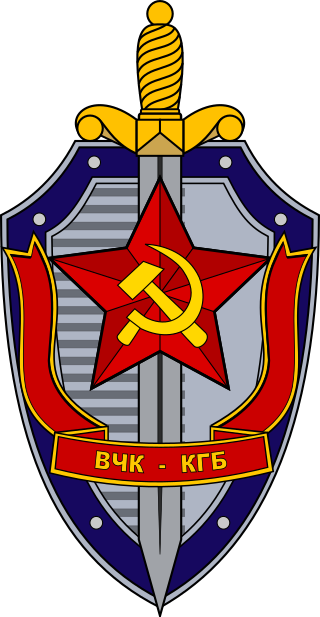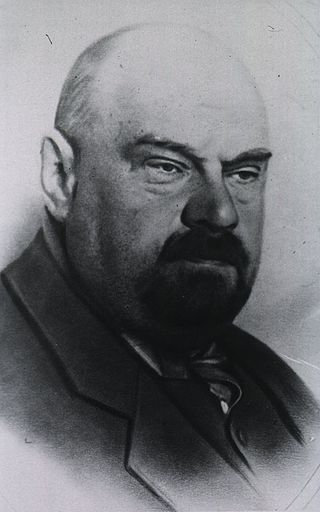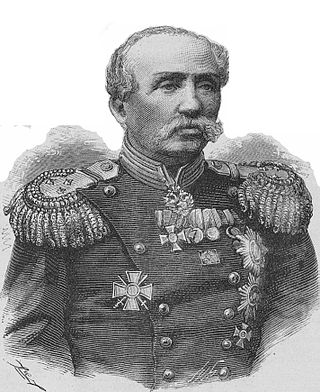
Kumyks are a Turkic ethnic group living in Dagestan, Chechnya and North Ossetia. They are the largest Turkic people in the North Caucasus.

The Imperial Russian Air Service was an air force founded in 1912 for Imperial Russia. The Air Service operated for five years and only saw combat in World War I before being reorganized and renamed in 1917 following the Russian Revolution.
The Battle of Konotop or Battle of Sosnivka was fought between a coalition led by the Hetman of Ukrainian Cossacks Ivan Vyhovsky and cavalry units of the Russian Tsardom under the command of Semyon Pozharsky and Semyon Lvov, supported by Cossacks of Ivan Bezpaly, on 29 June 1659, near the town of Konotop, Ukraine, during the Russo-Polish War (1654–1667). Vyhovsky's coalition defeated the Russians and their allies and forced the main Russian army to interrupt the siege of Konotop. However, the result of the battle only intensified political tensions in Ukraine and led to Vyhovsky's removal from power several months later.

Grunauer Alexander Adolfovich was a Soviet scientist and expert in the field of problems of regulation of internal combustion engines. An experienced teacher, professor. A Dr.Sci.Tech. (1969). Professor (1972). Chairman of department "Theory of mechanisms and machine" at the Kharkov polytechnical institute (1968—1993). The professor of the same department (1993—1994).

The Committee for State Security (CSS) was the main security agency for the Soviet Union from 13 March 1954 until 3 December 1991. As a direct successor of preceding agencies such as the Cheka, GPU, OGPU, NKGB, NKVD and MGB, it was attached to the Council of Ministers. It was the chief government agency of "union-republican jurisdiction", carrying out internal security, foreign intelligence, counter-intelligence and secret police functions. Similar agencies operated in each of the republics of the Soviet Union aside from the Russian SFSR, where the KGB was headquartered, with many associated ministries, state committees and state commissions.

Pyotr Borisovich Gannushkin was a Russian psychiatrist who developed one of the first theories of psychopathies known today as personality disorders. He was a student of Sergei Korsakoff and Vladimir Serbsky. Not only did he manage to delineate certain organizational tasks of social psychiatry, but he also clearly formulated the main methodological aim of social psychiatrists, to combine methods of individual clinical analysis with sociological research and generalization.

Freemasonry in Russia started in the 18th century and has continued to the present day. Russian Freemasonry pursue humanistic and educational purposes, but more attention is given to ethical issues. It was a spiritual community of people united in an effort to contribute to the prosperity of the Motherland and the enlightenment of the people living in it.

The Provisional Russian Administration in Bulgaria was an interim government established for Bulgarian territories occupied by the Imperial Russian Army during the Russo-Turkish War of 1877–1878. This administration was established in the beginning of the war in April 1877. The Treaty of Berlin (1878) provided for the termination of the Temporary Russian Governance activity since the establishment of the Principality of Bulgaria and Eastern Rumelia, in connection with which it was abolished in May 1879. The main objectives of the Temporary Russian administration was to establish peaceful life and preparation for a revival of the Bulgarian state.
The Glinski rebellion was a revolt in 1508 in the Grand Duchy of Lithuania by a group of aristocrats led by Prince Mikhail Glinski in 1508. It grew out of a rivalry between two factions of the nobility during the final years of Grand Duke Alexander Jagiellon. The revolt began when Sigismund I, the new Grand Duke, decided to strip Glinski of his posts based on rumors spread by Jan Zabrzeziński, Glinski's enemy. After failing to settle the dispute at the royal court, Glinski and his supporters rose up in arms. The rebels swore allegiance to Vasili III of Russia, who was waging war against Lithuania.

Ivan Stepanovich Ganetsky was an Imperial Russian division commander. He fought in wars in the Caucasus, Poland and against the Ottoman Empire.

Yakov Yakovlevich Brandt was a Russian sinologist, diplomat, linguist and professor.

Numan Yunusovich Satimov was a Soviet and Uzbek mathematician, Doktor Nauk in Physical and Mathematical Sciences, academician of the Academy of Sciences of Uzbekistan (2000), and corresponding member of the Academy of Sciences of UzSSR from 1979 to 2006, and a laureate of the Biruni State Prize (1985). He was a specialist in the theory of differential equations, control theory and their applications.

Vladimir Konstantinovich Soldatov was a Russian and Soviet ichthyologist, zoologist, Doctor of Biological Sciences, professor of the Department of Ichthyology of the Moscow Technical Institute for the Fishery Industry.

The history of metallurgy in the Urals stands out to historians and economists as a separate stage in the history of Russian industry and covers the period from the 4th millennium BC to the present day. The emergence of the mining district is connected with the history of Ural metallurgy. The geography of the Ural metallurgy covers the territories of modern Perm Krai, Sverdlovsk Oblast, Udmurtia, Bashkortostan, Chelyabinsk Oblast and Orenburg Oblast.

Air Intelligence of the Russian Air Force is a branch of Russian Air Force responsible for creating an intelligence picture for Air Force missions and participating in creating an overall intelligence picture. Russian aerial reconnaissance is one of the oldest in the world and began to operate back in 1911. Includes a number of reconnaissance and research units on various topics related to air warfare and collaborates with the Military Intelligence Directorate.

Nikolai Danilovich Morozkin is a Soviet and Russian mathematician. Doctor of Physical and Mathematical Sciences (1996), Professor (1997), Rector of Bashkir State University, Honorary Figure of Higher Education of the Russian Federation (2011).

The German occupation of Byelorussia, now known as Belarus, started with Germany's invasion of the Russian Empire on August 1, 1914 and ended with the collapse of the German Empire on November 11, 1918. During the occupation, 130,000 Belarusians were killed.
Russian–Kumyk wars — a series of military conflicts between the Russian Tsardom and the Kumyk Tarki Shamkhalate and other Kumyk states and feudal possessions during the 16th–18th centuries. At the end of the 18th century, as well as during and after the Caucasian War, and throughout the end of the 19th and the beginning of the 20th centuries, conflicts continued in the form of uprisings in Shamkhalate, Northern Kumykia, Southern Kumykia, and in the form of anti-colonial protests of individual villages (societies). In the result of these wars and uprisings, some Kumyk areas and villages were destroyed several times over.
Barrage is a military term covering a wide range of structures, devices, or measures for destroying something to constrain or impede the movement of troops and forces.
The Faraway Tsardom is an undefined realm of East Slavic folklore into which the hero fell or separated from the ordinary world by an impenetrable dense forests, abysses, seas or other obstacles. In Russian language it is referred to as Тридевятое царство, тридесятое царство.
















